

 中文摘要:
中文摘要:
运用森林景观模型LANDIS模拟"天然林保护工程"对大兴安岭呼中林业局潜在可获取木材、树种组成、年龄结构和景观格局的影响。结果表明:模拟100年后研究区森林潜在可采伐面积比例由10.7%增加到14.2%;伐后树种分布总面积几乎无变化,但兴安落叶松的分布面积降低了12%,白桦的分布面积增加了6.4%,云杉、樟子松、偃松、山杨、甜杨和钻天柳6个树种的变化均较小;与模拟初始相比,林分年龄结构也有很大改变,中幼龄林(林龄≤100年)的分布面积比例降低了10%,成熟林(101~140年)的分布面积降低了24%,过熟林和老龄林(林龄≥180年)的分布面积增加了33%;景观格局的聚集度降低,多样性增加。
 英文摘要:
英文摘要:
An explicit forest landscape model,LANDIS was used to simulate the impacts of‘Natural Forest Protection Project'on the boreal forest of Huzhong forestry bureau in the northern Great Xing'an mountain,China.The potential timber,forest species composition,age structure and spatial pattern index(the Aggregation index,AI;the diversity index,SHDI)was evaluated.The results indicated that the Nature Forest Protection Project would benefit total and most species(except spruce and aspen)potential timber in the mid-long term,and strongly altered the species composition,age structure and spatial pattern.though changes in the total species area were few.Comparing that in the initial simulation,the abundance of birch increased by 6.4%,larch abundance decreased by 12%,and other species abundance such as spruce,zhangzisong,yansong,aspen,popular and willow changed little.Forest age structure also responsed rapidly to the forest management regime,the abundance of unmature standing forest(age≤100yr)and mature forest repectively decreased by 10% and 24%,and the overmature standing forest(age≥180yr)increased to 33%.In addition,forest diversity and forest fragmentation would both increase under the current forest management regime.
 同期刊论文项目
同期刊论文项目
 同项目期刊论文
同项目期刊论文
 Seasonal Water Quality Upstream of Dahuofang Reservoir, China – the Effects of Land Use Type at Vari
Seasonal Water Quality Upstream of Dahuofang Reservoir, China – the Effects of Land Use Type at Vari 期刊信息
期刊信息
